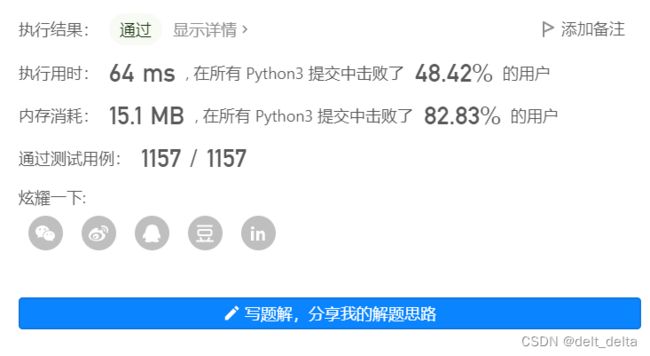力扣刷题笔记 Z字形变换
前言
本文是为了记录自己做题的思路,便于之后优化。
正文
看到题目的第一感觉是找规律:
s = "PAYPALISHIRING"
numRows = 4
print(len(s))
#6n
print(s[0],s[6],s[12])
#6n-1 6n+1
print(s[1],s[5],s[7],s[11],s[13])
#6n+2 6n-2
print(s[2],s[4],s[8],s[10])
# 6n+3
print(s[3],s[9])
输出结果为:
14
P I N
A L S I G
Y A H R
P I
结果与答案是一致的,所以这里利用这种找规律的方法进行获取,把这个总结成一个循环,但是在总结循环的时候发现,不是所有的都是这个规律,如果行数不是4的话,这个规律就不再适用了,同时对于这里面的元素,进行一一的异常排除也不现实,所以更改思路:
根据所给出的行数与原本的数字的索引来找规律,我们不难发现,纵向的数据个数为n个,斜着的个数为n-2个,所以每组对应的数目应当为2n-2个,这样看来,我们需要首先找到其终止位置对应的这里面的序列应当是第几个,也就是其下标截止于几,最简单的思考方法是利用一个新的数组存放这些数据,但是实际上这样做会浪费大量的内存,因此必须要用下标来表示,这里按照迭代的次数i来表示,最终结束是在某个特定的位置结束,迭代后每次变化的数字的个数为0,1,2,3…2n-3,也就是看何时达到一个最终的数值,这一簇结束位置为何处,修改代码后,如下:
s = "PAYPALISHIRING"
numRows = 4
T=2*numRows-2
string=list()
while True:
n=0
while True:
if T*n>=len(s):
break
else:
string.append(s[T*n])
n+=1
print(string)
for i in range(1,numRows-1):
n=0
while True:
if T*n+i<len(s):
string.append(s[T*n+i])
print(string)
else:
break
if T*(n+1)-i<len(s):
string.append(s[T*(n+1)-i])
print(string)
else:
break
n+=1
n=0
while True:
if T*n+numRows-1>=len(s):
break
else:
string.append(s[T*n+numRows-1])
print(string)
n+=1
print(len(string))
if len(string)==len(s):
break
['P']
['P', 'I']
['P', 'I', 'N']
['P', 'I', 'N', 'A']
['P', 'I', 'N', 'A', 'L']
['P', 'I', 'N', 'A', 'L', 'S']
['P', 'I', 'N', 'A', 'L', 'S', 'I']
['P', 'I', 'N', 'A', 'L', 'S', 'I', 'G']
['P', 'I', 'N', 'A', 'L', 'S', 'I', 'G', 'Y']
['P', 'I', 'N', 'A', 'L', 'S', 'I', 'G', 'Y', 'A']
['P', 'I', 'N', 'A', 'L', 'S', 'I', 'G', 'Y', 'A', 'H']
['P', 'I', 'N', 'A', 'L', 'S', 'I', 'G', 'Y', 'A', 'H', 'R']
['P', 'I', 'N', 'A', 'L', 'S', 'I', 'G', 'Y', 'A', 'H', 'R', 'P']
['P', 'I', 'N', 'A', 'L', 'S', 'I', 'G', 'Y', 'A', 'H', 'R', 'P', 'I']
14
转移到leetcode中去,出现了几个超时的,发现都是numRows=1的,所以修改代码如下:
class Solution:
def convert(self, s: str, numRows: int) -> str:
if numRows==1:
return s
T=2*numRows-2
string=list()
while True:
n=0
while True:
if T*n>=len(s):
break
else:
string.append(s[T*n])
n+=1
for i in range(1,numRows-1):
n=0
while True:
if T*n+i<len(s):
string.append(s[T*n+i])
else:
break
if T*(n+1)-i<len(s):
string.append(s[T*(n+1)-i])
else:
break
n+=1
n=0
while True:
if T*n+numRows-1>=len(s):
break
else:
string.append(s[T*n+numRows-1])
n+=1
if len(string)==len(s):
break
return ''.join(string)
